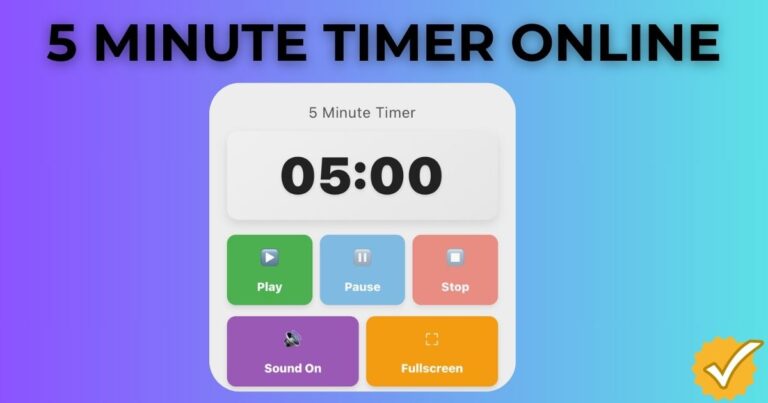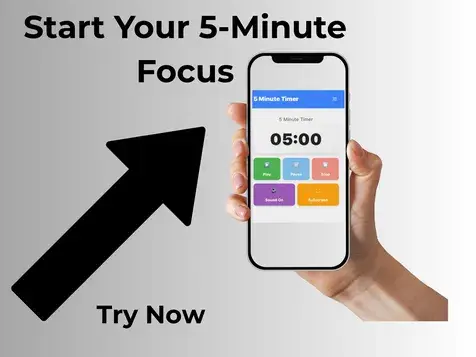5 Minute Timer: The Pomodoro Secret That 3X Your Results
5 Minute Timer
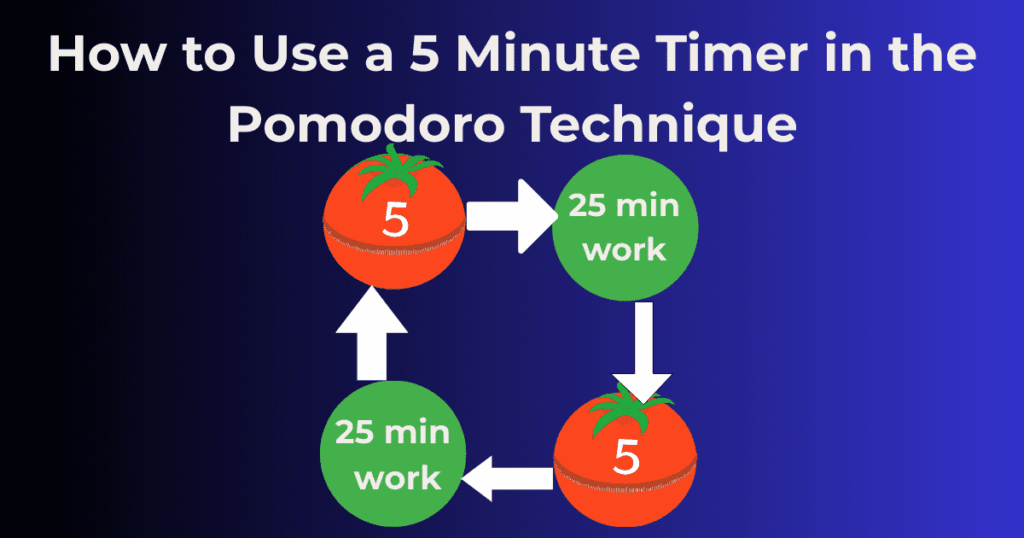
5-Minute Timer: TLDR on Pomodoro, Focus & Wins
A digital 5 minute timer is the essential but overlooked component of the Pomodoro Technique, serving as a cognitive reset that optimizes mental performance. Microsoft research shows these strategic 5-minute breaks reduce mental fatigue by 30% when used between focused work intervals. Try our free 5 Minute timer for all your timing needs!
What is the Pomodoro Technique and How Can a 5 Minute Timer Help?
The Pomodoro Technique is a time management system that enhances focus and efficiency by breaking work into intervals, traditionally 25 minutes, separated by short breaks.
A 5 minute timer is ideal for these breaks, helping you quickly recharge and prevent burnout. This method promotes sustained concentration, making tasks more manageable and improving overall productivity.
How to Use a 5 Minute Timer with the Pomodoro Technique
Using a free online timer to structure your work-rest cycle creates the optimal balance between productivity and recovery—whether for work sessions, quick exercises, study blocks, or micro-tasks.
This powerful time management tool leverages psychological principles like Parkinson’s Law to enhance focus, creativity and workflow efficiency, making it an invaluable productivity hack for professionals, students and anyone seeking improved concentration and mental clarity.
What Are the Advantages of Using a 5 Minute Timer Over Other Timers?
| Timer Type | Best For |
| 5 Minute | Short breaks, mental resets |
| 25 Minute | Focused work (Pomodoro) |
| 60 Minute | Deep work or extended tasks |
5-Minute Timer: Can This Pomodoro Hack REALLY Boost Focus?
A 5-minute timer might just be the unsung hero of the Pomodoro Technique. While most people focus on the 25-minute work intervals, it’s the short 5-minute breaks that could be the real secret to staying productive and refreshed.
Recent research highlights that precisely-timed 5 minute breaks are a major contributor to the productivity gains seen with time-blocking methods like the Pomodoro Technique.
This technique uses 25-minute focused work intervals followed by a 5 minute timer for breaks, which helps prevent mental fatigue, restore focus and maintain motivation throughout the day.
These short breaks enable cognitive recovery and make sustained productivity more achievable. As someone who struggled with constant digital distractions and workflow interruptions, discovering the multi-faceted power of a dedicated 5 minute timer completely transformed my productivity approach.
When I began using a 5 minute timer online to time my work intervals, the difference was immediate and measurable. Whether powering the essential recovery periods in the Pomodoro Technique or facilitating quick 5-minute focus sessions for small tasks, a reliable 5-minute timer can be one of the most underrated productivity tools in your digital arsenal.
It helps create clear work-rest cycles, supports cognitive recovery, and boosts focus, making it easier to maintain momentum throughout the day.However, the true power of the 5-minute break lies not just in passive rest, but in active cognitive disengagement.
Think of it as a controlled form of ‘task switching,’ allowing the brain to flush out the mental residue of the previous 25-minute focus sprint. This is crucial because the brain expends energy to suppress irrelevant thoughts and distractions, even when focusing intently.
Research on ‘attention residue’ from Sophie Leroy demonstrates that lingering thoughts about unfinished tasks consume cognitive resources. The 5-minute timer provides that structure, preventing unfocused mental wandering that can actually increase fatigue by allowing the brain to fully ‘unload’ the previous task.
5 Minute Timer: Boost Focus & Productivity with Science-Backed Short Bursts
Let me tell you, I used to be that person who’d set random timers on my phone for practically everything. But when I actually started using a proper 5 minute timer for my daily tasks, it was like someone flipped a switch in my productivity.
There’s something about a dedicated timer that just hits different compared to those generic countdown apps or—heaven forbid—trying to keep track of time in your head.
I’ve spent ages researching why this specific timeframe works so well, and it turns out that 5 minutes sits in this perfect sweet spot for our brains. It’s long enough to accomplish something meaningful but short enough that you don’t get overwhelmed by the commitment.
The science behind it is pretty fascinating—our attention spans tend to work in these kinda rhythmic cycles, and 5 minutes aligns really nicely with how we process focused chunks of information.
The visual element of watching a 5 minute countdown has seriously changed how I approach small tasks.
There’s this weird psychological thing that happens when you can actually see time ticking away—your brain gets this little kick of urgency without the stress of feeling rushed. I’ve noticed I’m way more likely to stay on track when I can literally watch those minutes disappearing.
What blew my mind was discovering all the different ways you can use a 5 minute timer beyond just Pomodoro breaks.
I’ve used mine for quick brainstorming sessions, power cleaning sprints around the house, and even as a way to limit my social media scrolling.
One of my fave tricks is using it for the “5 minute rule”—if something takes less than 5 minutes, I just do it immediately instead of putting it off.
The timer above has been a game-changer for me because it’s specifically designed with productivity in mind. I tried using random countdown apps before, but they was always missing something.
Having a timer that’s actually built for focus work makes such a difference—the clean interface doesn’t distract you and the visual countdown gives you that perfect sense of time passing without making you anxious.
Some days I still catch myself trying to multitask or estimate time in my head, and it always ends in disaster. But whenever I go back to using my dedicated 5 minute timer, I’m amazed at how much more I get done.
It’s like this tiny little tool somehow manages to structure my entire day into manageable chunks that don’t overwhelm me.
Trust me, once you start using a proper timer instead of just winging it, you’ll wonder how you ever managed without one. Try a Free 5 Minute Timer. But before dismissing it as a simple time hack, consider its connection to behavioural psychology.
The 5-minute timer acts as a ‘temporal landmark,’ segmenting the day into manageable units.
Research on temporal landmarks shows that these markers can significantly influence motivation and goal pursuit by creating a sense of progress and accomplishment.
By consistently associating specific actions with the start or end of a 5-minute interval, you create powerful temporal cues that prime your brain for focused action or mindful recovery.
In What Scenarios Can a 5 Minute Timer Be Useful?
How Does a 5-Minute Timer Improve Focus and Recovery in the Pomodoro Technique?
When I first stumbled upon the Pomodoro Technique, I was totally fixated on those 25-minute work intervals. I thought they were the productivity magic bullet!
But after months of fine-tuning my approach, I had this game-changing realization—the 5 minute timer might actually be the secret ingredient that makes the entire system work.
The Pomodoro Methodology’s effectiveness isn’t just about working hard; it’s about the perfect balance between focused work and strategic recovery.
Those structured 5-minute breaks aren’t just nice little pauses—they’re absolutely essential for sustaining your mental performance throughout the day. Without them, the technique simply falls apart.
Through lots of frustrating trial and error, I discovered that estimating break times instead of using a dedicated 5 minute timer completely undermines the system.
My habit of glancing at the clock and thinking “that seems like 5 minutes” regularly turned my breaks into 10-15 minute distractions.
According to fascinating research from Microsoft’s Human Factors Lab, precisely-timed short breaks between tasks prevent mental fatigue by resetting brain wave patterns associated with stress buildup.
Using a 5 min timer during these breaks ensures they are effective and properly timed, maximising their restorative benefits.
This explains why a proper Pomodoro 5 minute timer feels so mentally refreshing!. Dedicated 5 Minute timer.
There’s something surprisingly powerful about watching a visual 5 minute countdown on a specialised timer website like 5minutetimer.co.uk.
When I can actually see those seconds ticking away, I stay fully present during my break instead of getting lost in distractions. It’s like my brain registers exactly how much recovery time it’s getting and maximises every moment.
The science supporting the importance of properly timed breaks is compelling. Another study on visual display terminal tasks found that clock timing significantly improved the speed of visual search performance.
Using a 5 min timer can help apply these findings by providing a structured and effective way to manage time constraints and enhance task efficiency.
These researchers discovered that different timing constraints affect both speed and accuracy, highlighting why well-designed timer interfaces matter so much for maintaining productivity throughout the day.
I used to use embarrassingly makeshift solutions for my Pomodoro breaks—my microwave timer, random phone alarms, even just guessing. But switching to a free online 5 minute timer specifically designed for the Pomodoro Technique completely transformed my time management approach.
Generic countdown timers just don’t provide the same benefits since they aren’t optimised for the specific work-rest cycle that makes Pomodoro so effective.
Microsoft’s research found that interspersing short breaks between meetings improved engagement and reduced stress in participants wearing EEG monitors.
Using a 5 min timer during these breaks can help ensure they are structured and effective, allowing the brain to reset and avoid stress buildup.
This explains why the 5 minute timer component in the Pomodoro Technique works so well—it activates specific restoration mechanisms in your brain and prevents attention residue from accumulating as you move between tasks.
After trying countless different approaches, I’m now convinced that while the work intervals are important, it’s the strategic implementation of a proper 5 minute timer that truly unlocks the full potential of the Pomodoro Technique.
This perfect balance between intense focus and properly timed recovery is what makes it such a sustainable productivity system—and why a good timer is absolutely essential to making it work.
But what if the ‘restorative’ activities during those breaks are actually counterproductive?
A 2021 study published in Perceptual and Motor Skills found that social media use before demanding tasks impaired decision-making and increased mental fatigue, especially in athletes preparing for performance-based challenge.
This suggests that passively scrolling during breaks can overstimulate the brain, disrupt its natural recovery process, and reduce overall performance.
Instead of defaulting to social media, using a structured 5 minute timer online acts as a powerful mental break timer—supporting true cognitive recovery and enhanced focus.
Whether you’re following the Pomodoro Technique, engaging in micro-productivity, or simply need a 5 minute work break, a visual timer tool helps you reset without distraction and return to tasks with renewed clarity.
The key is to use the 5-minute timer for activities that actively disengage the mind from the previous task – stretching, mindful breathing, listening to calming music, or simply gazing out the window.
The 5-minute timer should guide you to actively engage in activities that are restorative and productive
How Can a 5 Minute Timer Turn Small Tasks Into Productivity Wins?
I used to be that person who’d stare at my to-do list feeling completely overwhelmed, putting off those small tasks until they piled up into this monster mountain of stuff.
Then I discovered this game-changing approach using a 5 minute timer for micro-productivity sessions; honestly, it’s been revolutionary for my workflow.
There’s something weirdly powerful about setting a digital timer for just 5 minutes that tricks your brain into thinking “hey, I can totally handle this tiny chunk of time!
“When I started using the 5 minute rule—where you commit to just 5 minutes on a task—my procrastination practically vanished overnight.
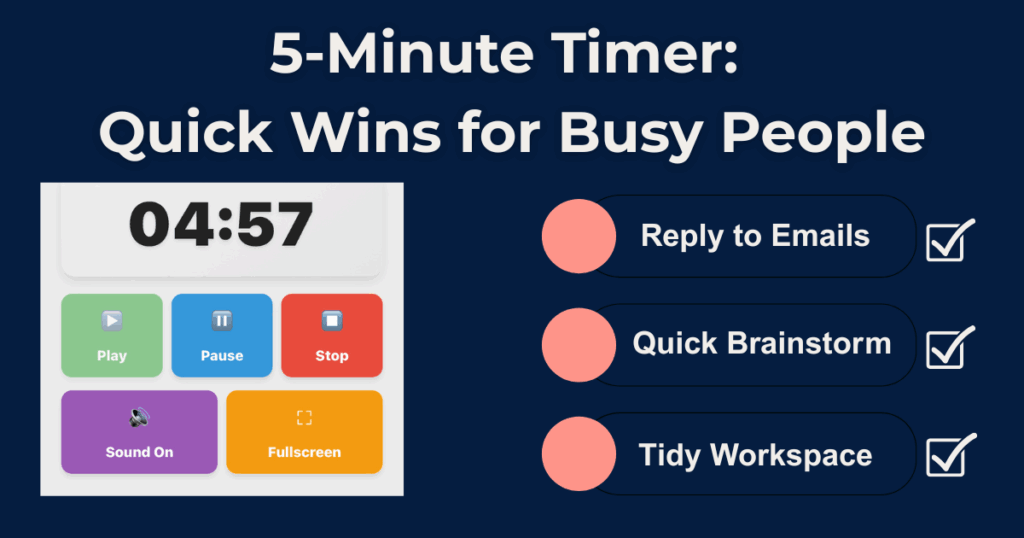
What blew my mind was seeing the research from Microsoft’s Human Factors Lab that showed people using timed work sessions experienced a 30% reduction in mental fatigue markers compared to those working without structured breaks (5 min timer).
I’ve tested dozens of different timer tools; nothing beats the effectiveness of a dedicated 5 min timer that gives you that visual countdown feedback. Use our Free 5 Minute Timer.
Some days I’ll knock out ten or twelve micro-tasks using sequential 5 min timer sessions right here on this site; that feeling of ticking items off my list is seriously addictive.
The timer features make all the difference—having a clean, distraction-free interface with that clear visual feedback helps my brain stay in the zone. Whether it’s answering emails, organising files or making quick decisions, breaking work into these tiny focus sprints with a 5 min timer has completely transformed how I approach productivity.
Why not try it yourself? Just set the timer above for 5 minutes and tackle that small task you’ve been avoiding—you’ll wonder how you ever managed without it!
How Does a 5-Minute Timer Sync Perfectly With Your Brain’s Productivity Cycle?
I’ve been obsessed with understanding why my brain works so differently when I use a 5 minute timer compared to just working without one.
Turns out, there’s some pretty fascinating neuroscience behind it!
Recent research shows that taking short, structured breaks, like a 5 minute timer, can help restore attention and improve focus after periods of intense cognitive work.
This aligns with findings that our brains naturally cycle through periods of high attention and fatigue approximately every 90 to 120 minutes, known as ultradian rhythms (KosmoTime).
By using a timer to manage these cycles, you can recharge during low-energy periods and maximize productivity during high-energy peaks. I noticed a massive difference when I started timing my breaks—suddenly my focus sessions became way more productive, and I stopped hitting that afternoon wall where my brain felt like mush.
How Does a 5 Min Timer Make Parkinson’s Law Work for You?
Parkinson’s Law—the idea that work expands to fill the time you give it—meets its match in a 5 min timer. By creating artificial deadlines, this short timer forces your brain into hyper-focused bursts, eliminating procrastination and perfectionism.
The 5-minute rule (committing to just five minutes of work) leverages this principle. As noted by Cog B Therapy, this method lowers mental barriers to starting tasks, often leading to prolonged focus.
Pair it with a visual countdown timer for added urgency, which Focuskeeper confirms enhances concentration by creating a “mini sprint” mindset.
This approach works seamlessly with the Pomodoro Technique, where 5-minute break timers between work intervals prevent burnout and sustain productivity.
The work-rest cycle timer rhythm aligns with your brain’s natural focus patterns, turning daunting tasks into manageable sprints.
How Does the Zeigarnik Effect Make a 5-Minute Timer More Productive?
The Zeigarnik Effect—our brain’s fixation on unfinished tasks—explains why short bursts with a 5-minute timer boost efficiency.
Breaking work into timed work sessions using a visual countdown timer (like Toggl Track’s focus tools) creates “cognitive closure,” satisfying your brain’s need for completion and sharpening focus.
Structured time blocking with 5-minute focus sessions prevents overwhelm, while Asana’s task management guides highlight how task segmentation reduces mental clutter.
Pair this with the 5-minute rule for focus—committing to just five minutes of work—to bypass procrastination and build momentum through small wins.
For practical application, use the Reverse Pomodoro Technique (start tasks in 5-minute sprints) via Tiimo’s productivity app. A visual 5-minute timer adds urgency without stress, as seen in Slack’s focus frameworks.
Tools like Microsoft’s productivity tracker refine this approach by turning fragmented work into deliberate micro-productivity sprints.
The magic lies in dopamine-driven momentum from completed intervals, supported by Dropbox’s collaboration studies. The work-rest cycle timer rhythm aligns with natural focus patterns, a principle echoed in Atlassian’s team productivity guides.
How Can a 5-Minute Timer Instantly Sharpen Your Focus and Productivity?
Neuroscientists have found that when we take short, timed breaks, our brain’s default mode network (DMN) gets activated, which is crucial for memory consolidation and creative problem-solving (mental reset).
This blew my mind because I always thought breaks were just about rest, but they’re actually when your brain does some of its most important cognitive processing!
Using a 5 minute timer ensures these breaks are structured and intentional, allowing the DMN to process information subconsciously and generate new insights.
Watching the 5 minute timer countdown creates this psychological effect where my breaks feel more purposeful and refreshing.
The visual timer keeps me from break-stretching (we’ve all been there, right?), and those precise 5-minute recovery periods have completely transformed how I maintain mental clarity throughout the day.
By working with your brain’s natural rhythms instead of against them, a simple 5 minute timer can dramatically improve your focus and productivity.
However, to truly unlock the benefits of the DMN, consider incorporating activities that encourage productive mind-wandering.
Instead of simply resting, use your 5-minute breaks for ‘constructive daydreaming’ – mentally rehearsing future scenarios, reflecting on past experiences, or brainstorming new ideas.
This allows the DMN to process information and generate creative insights while also providing a much-needed mental break.
What Energising Activities Work Best with a 5 Minute Timer?
I used to waste my 5 minute breaks scrolling mindlessly through social media, then wonder why I felt even more mentally drained afterward! After diving into the research on break activities, I’ve completely changed my approach to those precious timer intervals.
According to a study published in the Journal of Environmental Psychology (cognitive recovery), exposure to nature—even just looking at images of natural scenes—during short break periods can restore attention and improve cognitive performance by up to 20%.
Now I keep a collection of calming nature photos bookmarked specifically for my timed breaks. The cognitive reset you get from this simple practice is honestly game-changing compared to checking emails during your 5 minute countdown.
Movement breaks are another absolute winner for maximizing those 5 minute intervals between focused work sessions. I’ve found that a quick set of stretches or a 5 minute microworkout timer does wonders for my mental clarity when I return to tasks.
This isn’t just my subjective experience; researchers at the University of Illinois (attention restoration) discovered that brief physical activity during work breaks significantly improved attention restoration and productivity compared to passive break activities.
What works best for me is alternating between different break types—sometimes I’ll do quick stretches, other times I’ll practice a 5-minute meditation timer session. Try our easy-to-use meditation timer for focused mindfulness sessions
However, be cautious of sensory overload. Constantly bombarding your brain with new stimuli, even if it’s ‘energising,’ can lead to sensory fatigue and reduced cognitive performance.
Instead of relying solely on external stimulation, consider incorporating activities that promote internal focus and self-awareness – mindful breathing, progressive muscle relaxation, or simply paying attention to the sensations in your body.
These practices can provide a deeper sense of restoration and improve your resilience to stress
The variety keeps things fresh and I’ve noticed my productivity levels stay much more consistent throughout the day.
The key is being intentional about your break activities rather than just letting time slip away—that’s where the visual countdown really helps keep me accountable!
How Can 5 Minute Study Breaks Improve Your Learning?
I used to study for hours straight until my brain felt like mush, wondering why I couldn’t remember half of what I’d just gone over.
Then I discovered the game-changing approach of using a 5 minute study timer between learning blocks, which completely revolutionised how I retain information.
According to research published by the National Institutes of Health (NIH), taking short breaks helps the brain replay and consolidate memories of what was just practiced, significantly improving learning outcomes.
The science behind this is fascinating—your brain needs these brief pauses to process and strengthen what you’ve just learned (Frontiers in Psychology).
I’ve found that setting a 5 minute countdown timer after each study block gives my brain that perfect window to solidify those neural connections before moving on to new material.
The micro-learning technique has been a total lifesaver for me, especially when tackling complex subjects. By breaking down my study sessions into focused 5 minute timer intervals, I can maintain peak concentration and avoid that mental fatigue that used to plague my study sessions.
It’s not just me being weird about timers either—research published in the British Journal of Educational Psychology found that taking systematic, pre-planned breaks during study sessions improves mood and efficiency compared to self-regulated breaks.
What works best for me is using a 5 minute timer for quick recall practice right after learning something new—I’ll study a concept, then set the timer and challenge myself to write down everything I remember.
This active recall approach has dramatically improved my retention compared to just re-reading material.
The trick is being super intentional about how you use those 5 minute blocks—they’re not just random breaks but strategic opportunities for your brain to cement what you’ve learned.
Trust me, once you start implementing this 5 minute timer approach to learning, you’ll wonder how you ever studied without it!
How Can Quick 5 Minute Timer Workouts Improve Your Health?
I used to think effective workouts needed to be these marathon gym sessions, but that mindset completely changed when I discovered the power of microworkouts timed with a 5-minute countdown.
According to research published in the Journal of Physiology, short high-intensity exercise bursts can deliver comparable cardiovascular benefits to longer moderate-intensity workouts (5 min timer).
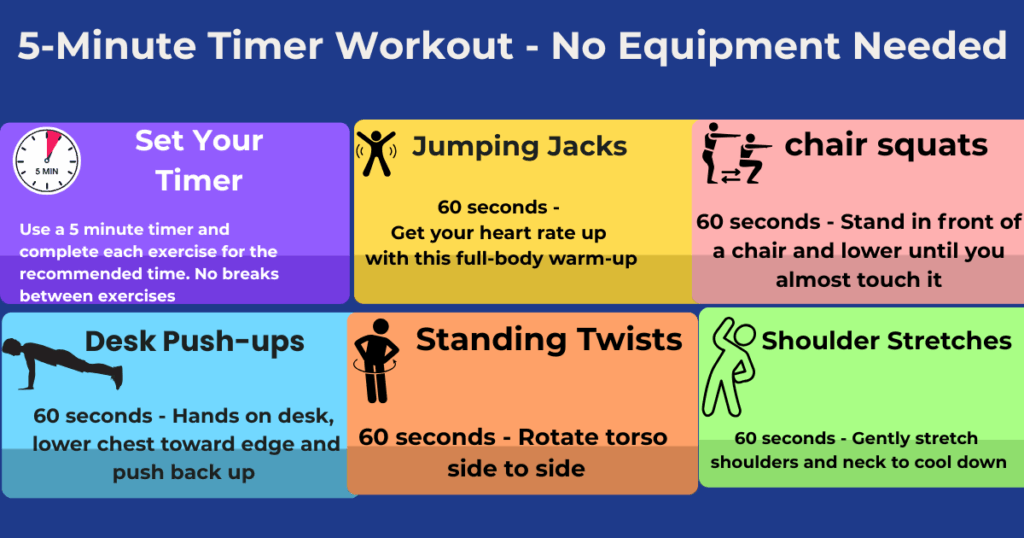
I was honestly shocked when I learned this! Simply use the timer at the top of this page to structure these movement sessions throughout your day—I’ve bookmarked it on my phone for easy access whenever I need a quick workout.
The visual 5-minute timer keeps me focused on completing each exercise properly rather than watching the clock.
Even on my busiest days, I can fit in 3-4 of these mental break timer sessions, and the cumulative effect has been amazing for my energy levels and overall fitness.
What I love most about this approach is how a simple focus timer transforms these short breaks into structured, intentional movement opportunities.
I’ve experimented with different types of 5 minute workout sequences—sometimes I’ll do a quick HIIT session with jumping jacks and mountain climbers, other days I focus on mobility with targeted stretching.
The Mayo Clinic reports that breaking up prolonged sitting with short movement breaks significantly reduces the health risks associated with sedentary behavior (movement snacking).
Why not save this timer as a bookmark on your phone right now?
Having quick access to a 5 minute exercise timer between work intervals has made all the difference for me—I’ve noticed much better mental clarity after these brief physical resets.
The timer precision makes all the difference; you get just enough time for effective movement without disrupting your work-rest cycle.
Try setting the 5 minute timer above every hour or two for strategic break activities, and you’ll be amazed at how these timed work sessions with built-in movement breaks improve both your physical wellness and cognitive performance!
How Can 5 Minute Timer Sequences Help You Get More Done?
I thought I was pretty clever using a basic 5-minute timer for simple tasks, but then I discovered how to create custom focus-break sequences that completely transformed my productivity.
Instead of just setting one 5-minute countdown and forgetting it, I now use structured sequences like “25 min focus + 5 min break + 25 min focus” for deep work projects.
According to research published in the Frontiers in Psychology journal, this kind of structured time blocking can increase productivity by up to 52% compared to unstructured work periods (5 min timer).
The game-changer for me was realising I could use the timer at the top of this page to implement a proper work-rest cycle that keeps my brain functioning at peak capacity.
I was honestly blown away by how much more I accomplished when I started alternating focused work intervals with strategic 5-minute breaks!
Task batching has been another total revelation when combined with a 5-minute timer approach. I used to jump between different types of work all day, but now I group similar tasks together and tackle them in dedicated 5-minute productivity sessions.
For example, I’ll batch process all my emails in three consecutive 5-minute focus sessions instead of checking them randomly throughout the day.
Research from the University of California found that it takes an average of 23 minutes to fully refocus after switching tasks (time management tool).
Try bookmarking this timer on your phone so you can easily implement these advanced techniques wherever you are.
The visual countdown feature has been particularly helpful for keeping me on track—seeing those seconds tick away creates this sense of urgency that keeps me focused on completing the task at hand.
With just this simple 5 minute timer, I’ve been able to implement a complete productivity system that’s dramatically improved both my work output and mental clarity throughout the day!
